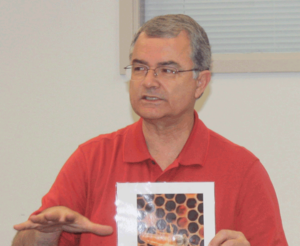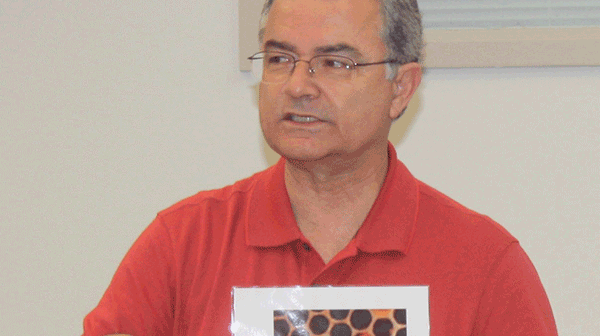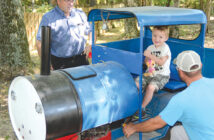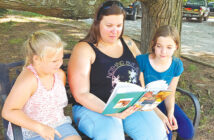
Terry Rosvall wanted a home garden. But there was a hitch: there weren’t enough bees to pollinate the garden plot. So the Rosvall family adopted two beehives in 2012.
“Beekeeping and everything associated with the pollinators have become my passion,” Rosvall said.
What began as a hobby to save a home garden has now blossomed into a small business and a growing abundance of hives now known as Reedy Creek Apiary.
The beekeeper’s fascination and devotion to bee life and work is for a good reason.
According to Reedy Creek Apiary, bee populations are currently on the decline, with beekeepers losing 40 to 50 percent of their beehives every year. One-third of the food people eat requires pollination, and honey bees do 80 percent of that pollination.
Besides keeping vigilance on the beehives, harvesting the honey is work.
A smoker, a contraption that looks a genie lamp, is used to smoke and calm the bees — but doesn’t harm them — so the raw honey and honeycombs can be gathered. A long, flat-blade knife-spatula is used to scrape honey from the honeycombs. Some of the honey is lightly filtered. The filtered honey is placed in a huge bucket-type container with filter screens, the honey runs through it, comes out of a spigot and is put into bottles for storage.
In the hives are four drawers, each with a honeycomb. Rosvall says he takes two drawers for his honey and leaves two for his bees to feed on. “I don’t want my girls hungry,” he said. This pattern is followed with all the hives.
He calls the bees in his hives “his girls” because the worker bees in the hive are female. The female bees gather the nectar and pollen.
The queen’s job is to lay eggs, not one or even a dozen, but 2,000 eggs a day.
“It takes a lot of bees to make honey, and a lot of honey to make the wax,” he said. “ It takes about 10 pounds of honey to make a pound of wax, which is the comb.”
During the winter there are only about 10,000 bees in a hive, Rosvall said. During the summer, there are about 60,000. He explained that when winter arrives, the female bees kick out the males. In the spring new ones will be born. A queen bee lives about five years, and worker bees live about a month.
Rosvall touts honey’s health benefits. It is an energy booster, regulates blood sugar levels, boosts the immune system and helps wounds heal. It is an anti-allergenic, sore throat and cough remedy, memory boost, sleep aid, can be used for skin care and has anti-cancer properties.
Everyday products are made from beeswax such as candles, lip balm, and hand and body cream.
Rosvall’s garden isn’t the only benefactor from his beehives. He shares his honey with neighbors as gratitude for them letting his bees gather their nectar and pollen.
The beehives are really personal with the Rosvall family as the beekeeper names each of his hives after family members.
Rosvall shares his passion by occasionally presenting programs to other bee enthusiasts.





2 Comments
Drones, the male bee, does not forrage at all, they are simply there to mate with queen bees. All foraging is done by female bees.
Thanks for the note. Story has been updated.